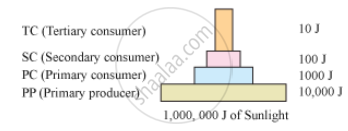Advertisements
Advertisements
Question
'The pyramid of energy is always upright.' Explain
Solution
The pyramid of energy represents the total amount of energy consumed by each trophic level in a given food chain. An energy pyramid is always upright because the total amount of energy available for utilization in the top levels is less than the energy available in the lower levels. This happens because according to the 10% law of energy transfer, only 10% of the total energy is transferred from one trophic level to another.

APPEARS IN
RELATED QUESTIONS
“It is often said that the pyramid of energy is always upright. On the other hand, the pyramid of biomass can be both upright and inverted.” Explain with the help if examples and sketches.
In an ecosystem dominated by trees, the pyramid (of numbers) is _________ type.
Which organisms constitute the last trophic level?
Answer the following question.
Write any two limitations of ecological pyramids.
Explain with the help of labelled diagrams, the difference between an upright pyramid of biomass and an inverted pyramid of biomass.
Secondary consumers are __________.
Define ecological pyramids.
In an aquatic ecosystem, a mollusc typically belongs to-
Draw a diagram of pyramid of energy.
The biomass of a standing crop of phytoplankton is 4 kg/m2, which supports a large standing crop of zooplankton having a biomass of 11 kg/m2. This is consumed by small fishes having a biomass of 25 kg/m2, which are then consumed by large fishes with a biomass of 37 kg/m2.
Draw an ecological pyramid indicating the biomass at each stage and also name the trophic levels. Mention whether it is an upright or inverted pyramid.
